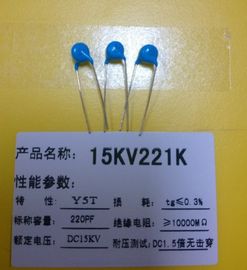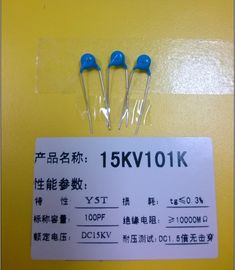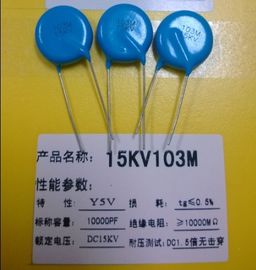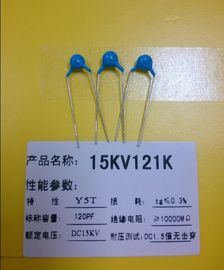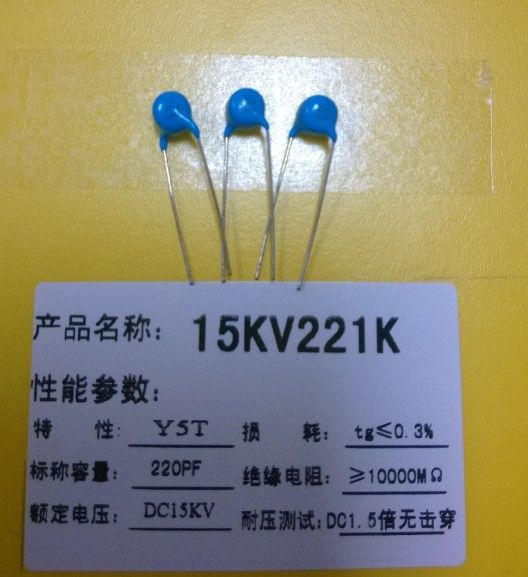High voltage ceramic capacitors X - Ray Equipments 221k capacitor
Product Details:
| Place of Origin: | Dongguan,Guangdong,China |
| Brand Name: | UCHI |
| Certification: | ROHS,ISO9001,etc. |
| Model Number: | 15KV221K |
Payment & Shipping Terms:
| Minimum Order Quantity: | 1000 |
|---|---|
| Price: | Negotiable |
| Packaging Details: | Bulk |
| Delivery Time: | 7-10 workdays |
| Payment Terms: | L/C, T/T, Western Union, MoneyGram |
| Supply Ability: | 1000000pcs per week |
|
Detail Information |
|||
| Features: | High Capacitance In Small Size | Product Name: | High Voltage Ceramic Capacitor |
|---|---|---|---|
| Rated Voltage: | 15KV DC | Insulation Resistance: | More Than 10000Mohm |
| Capacitance: | 220pF | Shape: | Disc |
| Replacement Of Brand: | AVX,NXP | Country Of Original: | China |
| Delivery Time: | 10 Days | Payment: | T/T PAYPAL |
| Highlight: | radial ceramic capacitor,disc ceramic capacitor |
||
Product Description
High voltage ceramic capacitors X - Ray Equipments 221k capacitor
Description
Class 2 ceramic capacitors
Class 2 ceramic capacitors have a dielectric with a high permittivity and therefore a better volumetric efficiency than class 1 capacitors, but lower accuracy and stability. The ceramic dielectric is characterized by a nonlinear change of capacitance over the temperature range. The capacitance value also depends on the applied voltage. They are suitable for bypass, coupling and decoupling applications or for frequency discriminating circuits where low losses and high stability of capacitance are less important. They typically exhibit microphony.
Class 2 capacitors are made of ferroelectric materials such as barium titanate (BaTiO
3) and suitable additives such as aluminium silicate, magnesium silicate and aluminium oxide. These ceramics have high to very high permittivity (200 to 14,000), which depends on the field strength. Hence the capacitance value of class 2 capacitors is nonlinear. It depends on temperature and voltage applied. Additionally class 2 capacitors age over time.
However, the high permittivity supports high capacitance values in small devices. Class 2 capacitors are significantly smaller than class 1 devices at the equal rated capacitance and voltage. They are suitable for applications that require the capacitor to maintain only a minimum value of capacitance, for example, buffering and filtering in power supplies and coupling and decoupling of electric signals.
Class 2 capacitors are labeled according to the change in capacitance over the temperature range. The most widely used classification is based on the EIA RS-198 standard and uses a three-digit code. The first character is a letter that gives the low-end operating temperature. The second gives the high-end operating temperature, and the final character gives capacitance change over that temperature range:
Class 2 ceramic capacitors
Code system regarding to EIA RS-198 for some temperature ranges and inherent change of capacitance
| Letter code low temperature |
Number code upper temperature |
Letter code change of capacitance over the temperature range |
| X = −55 °C (−67 °F) | 4 = +65 °C (+149 °F) | P = ±10% |
| Y = −30 °C (−22 °F) | 5 = +85 °C (+185 °F) | R = ±15% |
| Z = +10 °C (+50 °F) | 6 = +105 °C (+221 °F) | S = ±22% |
| 7 = +125 °C (+257 °F) | T = +22/−33% | |
| 8 = +150 °C (+302 °F) | U = +22/−56% | |
| 9 = +200 °C (+392 °F) | V = +22/−82% |
For instance, a Z5U capacitor will operate from +10 °C to +85 °C with a capacitance change of at most +22% to −56%. An X7R capacitor will operate from −55 °C to +125 °C with a capacitance change of at most ±15%.
Some commonly used class 2 ceramic capacitor materials are listed below:
X8R (−55/+150, ΔC/C0 = ±15%),
X7R (−55/+125 °C, ΔC/C0 = ±15%),
X5R (−55/+85 °C, ΔC/C0 = ±15%),
X7S (−55/+125, ΔC/C0 = ±22%),
Y5V (−30/+85 °C, ΔC/C0 = +22/−82%),
Z5U (+10/+85 °C, ΔC/C0 = +22/−56%),
Electronic Performances
| Materials | Y5T |
| Comsuption | t.g.≤0.3% |
| Norminal Capacitance | 220pF |
| Insulation Resistance | More than 10000Mohm |
| Rated Voltage | 15KV DC |
| Withstand Test | DC 1.5Times , no breakdown |
Product Photos
![]()



